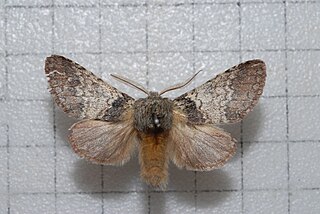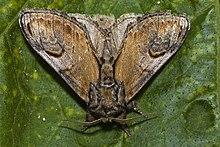
The Noctuidae, commonly known as owlet moths, cutworms or armyworms, are a family of moths. They are considered the most controversial family in the superfamily Noctuoidea because many of the clades are constantly changing, along with the other families of the Noctuoidea. It was considered the largest family in Lepidoptera for a long time, but after regrouping Lymantriinae, Catocalinae and Calpinae within the family Erebidae, the latter holds this title now. Currently, Noctuidae is the second largest family in Noctuoidea, with about 1,089 genera and 11,772 species. This classification is still contingent, as more changes continue to appear between Noctuidae and Erebidae.

Notodontidae is a family of moths with approximately 3,800 known species. The family was described by James Francis Stephens in 1829. Moths of this family are found in all parts of the world, but they are most concentrated in tropical areas, especially in the New World.

Noctuoidea is the superfamily of noctuid or "owlet" moths, and has more than 70,000 described species, the largest number of any Lepidopteran superfamily. Its classification has not yet reached a satisfactory or stable state. Since the end of the 20th century, increasing availability of molecular phylogenetic data for this hugely successful radiation has led to several competing proposals for a taxonomic arrangement that correctly represents the relationships between the major lineages.

Thaumetopoeinae is a subfamily of moths in the family Notodontidae. This group is sometimes treated as a family Thaumetopoeidae with three subfamilies: Thaumetopoeinae, Anaphinae and Epicominae. However, it is now commonly treated at subfamily rank based on morphological and molecular phylogenetic evidence.

Eupterotidae is a family of insects in the order Lepidoptera with more than 300 described species.

Ptilodoninae is a subfamily of the moth family Notodontidae. They are sometimes merged into the Notodontinae. The genus list is preliminary, as not all Notodontidae have been assigned to subfamilies yet.

Pygaerinae is a subfamily of the moth family Notodontidae, the silver prominents and relatives. The genus list is preliminary, as not all Notodontidae have been assigned to subfamilies yet.

Leucodonta bicoloria, the white prominent, is a moth from the family Notodontidae. It ranges from Western Europe (Ireland) to Hokkaido (Japan) being found in the northern part of Middle Europe, Northern Europe and Russia to the Amur region. In the western parts of the range it is a local and rare species. It is likely extirpated in Britain but a population was recently rediscovered in Ireland. The habitat requirements of the species are a bit unusual, it seems to prefer locally warm deciduous and mixed forests, where birch, the sole host plant, forms the canopy. The moth survives winter as a pupa underground.
Platychasmatinae is a small East Asian subfamily of the moth family Notodontidae. Only two genera are placed here at present:

Dioptinae is a subfamily of the moth family Notodontidae.

The Erebidae are a family of moths in the superfamily Noctuoidea. The family is among the largest families of moths by species count and contains a wide variety of well-known macromoth groups. The family includes the underwings (Catocala); litter moths (Herminiinae); tiger, lichen, and wasp moths (Arctiinae); tussock moths (Lymantriinae), including the arctic woolly bear moth ; piercing moths ; micronoctuoid moths (Micronoctuini); snout moths (Hypeninae); and zales, though many of these common names can also refer to moths outside the Erebidae. Some of the erebid moths are called owlets.
Chrysoglossa maxima is a moth of the family Notodontidae first described by Herbert Druce in 1897. It is found in Panama, Costa Rica and Guatemala.

Pseudofentonia is a genus of moths of the family Notodontidae erected by Embrik Strand in 1912.

Neodrymonia apicalis is a moth of the family Notodontidae first described by Frederic Moore in 1879.
Nystaleinae is a subfamily of the moth family Notodontidae. The subfamily was described by William Trowbridge Merrifield Forbes in 1948.
Neodrymonia rufa is a moth in the family Notodontidae. It was described by Yang in 1995. It is found in northern Vietnam and the Chinese provinces of Yunnan, Jiangxi, Hunan and Fujian.
Afrocerura cameroona is a moth in the family Notodontidae first described by George Thomas Bethune-Baker in 1927. It is found in Cameroon, the Democratic Republic of the Congo, Gabon and São Tomé & Principe.

Heterocampinae is a subfamily of prominent moths in the family Notodontidae. There are at least 60 described species of Heterocampinae in North America.













